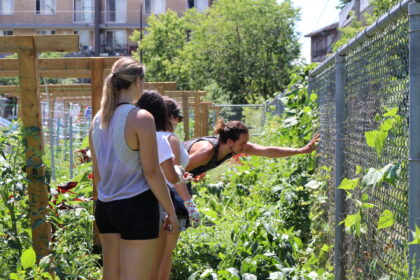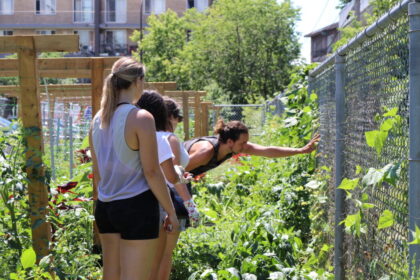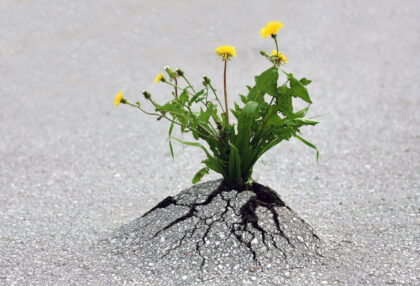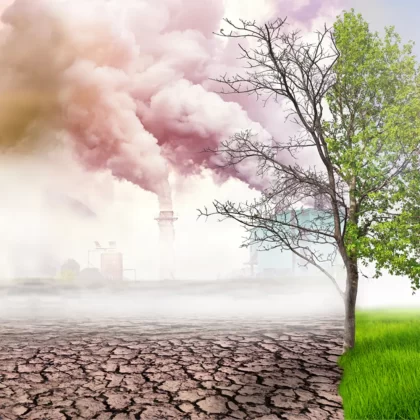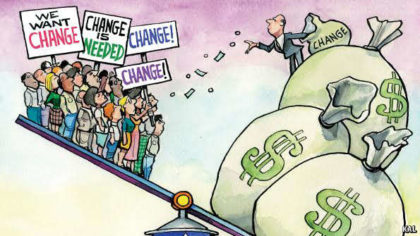
Description
Urban Agriculture URBS/GEOG 337
Updates
Your third blog is now due on Monday, December 6th.
Your final project is now due on Monday, December 13th.
Lessons
Course Information
Classroom: H 507 SGW
Office Hours: By Request via Zoom
Email Address: urbanagriculture@erikchevrier.ca
Course Description
Food is at the center of many serious social, political and economic issues, like starvation, obesity, eating disorders, malnutrition, climate change, pollution, biodiversity loss, inequality, colonization, and imperialism, among other topics. Food is more than just a biological need; it is also how people interact with the biosphere, express culture and communicate about class/gender/race relations. Although food sustains people daily, modern industrial agriculture is causing the planet to become unsustainable for future generations.
In this course, we critically analyze the possibilities and limitations of urban agriculture as a way to improve our food system, become food sovereign, promote food justice, and build community food security. We will learn about the history of urban agriculture and read case studies about modern urban agriculture projects in Canada and worldwide. We will also ‘get our hands dirty’ by getting involved with urban agriculture projects in and around our communities.
Course Evaluation
| Assignment | Grade Weight | Due Date |
| Blog (Essay) 1 – Food Production | 25% | October 8th |
| Blog (Essay) 2 – Strengths and Limits of Urban Agriculture | 25% | November 5th |
| Blog (Essay) 3 – Examples of Successful Urban Agriculture | 25% | December 6rd |
| Community Service Learning Project | 20% | December 13th |
| Participation | 5% | Ongoing |
Blog Posts (Essays about Urban Agriculture): Students will write two blogs of about 600 – 1000 words about a topic related to urban agriculture covered in the course lectures and/or required readings. The first blog must include themes related to urban food production, the second blog must include subjects related to the strengths and limitations of urban agriculture, and the third blog must include examples of successful urban agriculture. Although this is a blog, the information conveyed must come from research, not conjecture. In addition, the blog must contain at least five reliable, valid, credible sources and reference the course readings. Students with production skills can produce a video or a podcast instead of a blog; however, this must also be approved by me (Erik Chevrier).
Community Service Learning Project: Students must get involved with an urban farming initiative for at least ten hours during the semester. Students may also get involved with a project that advances urban farming but is not farm work (research, setting up markets, transforming food for an urban farm).
You must be in a group of at least 3 people (unless I permit you to have a different arrangement). You must all contribute to the report, but you can get graded for your individual contribution if you wish. If you are not part of a group and didn’t get permission to work independently, your grade will be reduced by 15%.
Participation: You will receive 2.5 out of 5 points for attending all the classes. The remainder of the grade is based on your involvement in discussion and participation in classroom activities.
Letter Grade Equivalency
Your numerical grades will be converted to letter grades as follows:
A+ (93 – 100%) B+ (77 – 79.9%) C+ (67 – 69.9%) D+ (57– 59.9%)
A (85 – 92.9%) B (73 – 76.9%) C (63 – 66.9%) D (53 – 56.9%)
A- (80 – 84.9%) B- (70 – 72.9%) C- (60 – 62.9%) D- (50 – 52.9%)
F < 50%
Handing in Assignments:
You MUST submit all assignments in HARD COPY at the beginning of class on the due date. Unless you are given permission (in advance), assignments received by e-mail will not be graded. Late assignments will not be accepted without adequate documentation of medical or personal emergencies.
Required Books
Cockrall-King, J. (2012) Urban Agriculture and the New Food Revolution, Prometheus Books.
Carpenter, N., and Rosenthal, W. (2011) The Essential Urban Farmer, Penguin Books.
Recommended Books for Advanced Students
Hemenway, T (2009) Gaia’s Garden: A Guide to Home-Scale Permaculture, 2nd Edition, Chelsea Green.
Course Readings and Schedule
This is a TENTATIVE schedule and is subject to change. Be sure to consult the course website regularly to be aware of any changes.
Course schedule, topics and required readings:
September 10th – Introduction to the Course
September 17th – Introduction to Growing Food in a City
Visit the Duff-Court Urban Farm
Reading:
Carpenter, N., and Rosenthal, W. (2011) The Essential Urban Farmer, Penguin Books.
Chapter 5 – Planning What to Grow and Raise (p. 67 – 88)
Chapter 7 – Container Gardening (p. 113 – 134)
September 24th – Introduction to Building Soil, Maintaining Crops, and Managing Pests
Reading:
Carpenter, N., and Rosenthal, W. (2011) The Essential Urban Farmer, Penguin Books.
Chapter 8 – Building Soil Fertility (p. 135 – 159)
Chapter 10 – Planting and Maintaining Crops (199 – 237)
Chapter 13 – Managing Weeds, Pests and Disease (p. 278 – 304)
October 1st – Introduction to Seed Saving and Growing Fruit Trees
Second Visit to the Duff-Court Urban Farm
Reading:
Carpenter, N., and Rosenthal, W. (2011) The Essential Urban Farmer, Penguin Books.
Chapter 14 – Seed Saving (p. 305 – 324)
Chapter 15 – Fruit Trees (p. 325 – 356)
October 8th – What’s Wrong with Our Food System
Visit Loyola Campus (Mind Hearth Mouth)
Reading:
Cockrall-King, J. (2012) Urban Agriculture and the New Food Revolution, Prometheus Books.
Chapter 1 – The Facade of the Modern Grocery Store (p. 23 – 31)
Chapter 2 – Industrial Food (p. 33 – 46)
Chapter 3 – Industrial Eaters (p. 47 – 57)
October 15th– Rise of Urban Agriculture
Reading:
Cockrall-King, J. (2012) Urban Agriculture and the New Food Revolution, Prometheus Books.
Chapter 4 – A World Food In Crisis (p. 59 – 72)
Chapter 5 – The New Food Movement and the Rise of Urban Agriculture (p. 73 – 80)
Chapter 15 – Conclusion: Greening and Eating Our Cities (p. 307 – 316)
Landner, P. (2011) The Urban Food Revolution, Changing the Way We Feed Cities, New Society Publishers.
Chapter 1 – What’s the Matter with Food (p. 1 – 10)
October 22nd – Localizing Food via Urban and Suburban Farming
Reading:
Landner, P. (2011) The Urban Food Revolution, Changing the Way We Feed Cities, New Society Publishers.
Chapter 2 – Past Forward to Local? Let’s Be Real (p. 11 – 24)
Chapter 3 – Preserving Rural Agriculture Land for Food Production (p. 25 – 34)
Chapter 4 – Converting Urban and Suburban Lands for Growing (p. 35 – 48)
Chapter 16 – Is Local Food Safe (p. 231 – 237)
October 29th – Making Urban Farms Viable
Reading:
Landner, P. (2011) The Urban Food Revolution, Changing the Way We Feed Cities, New Society Publishers.
Chapter 7 – Economic Sustainability: Making the Economics of Agricultural Urbanism Pay (p. 81 – 100)
Chapter 8 – Economic Development through Urban Agriculture (p. 101 – 116)
Chapter 12 – Farmers Markets and CSAs: Making the Most of Direct Sales (p. 167 – 180)
November 5th – Building Community via Urban Agriculture
Reading:
Landner, P. (2011) The Urban Food Revolution, Changing the Way We Feed Cities, New Society Publishers.
Chapter 13 – Growing Community with Community Gardens (p. 181 – 195)
Chapter 17 – What We Can Do: Systemic Changes, Personal Choices (p. 239 – 257)
November 12th – Roots of Modern Urban Agriculture
Reading:
Cockrall-King, J. (2012) Urban Agriculture and the New Food Revolution, Prometheus Books.
Chapter 6 – Paris – The Roots of Modern Urban Agriculture (p. 81 – 105)
November 19th –Urban Agriculture in Canada
Reading:
Cockrall-King, J. (2012) Urban Agriculture and the New Food Revolution, Prometheus Books.
Chapter 9 – Vancouver – Canada’s Left Coast (p. 159 – 197)
Chapter 10 – Toronto – Cabbagetown 2.0 (p. 199 – 226)
November 26th – Urban Agriculture on a National Scale in Cuba
Reading:
Cockrall-King, J. (2012) Urban Agriculture and the New Food Revolution, Prometheus Books.
Chapter 14 – Cuba – Urban Agriculture on a National Scale (p. 283 – 305)
December 3rd – Course Wrap-Up
A list of Student Services and Useful Resources
Counselling and Psychological Services: http://concordia.ca/students/counselling-life-skills
Concordia Library Citation and Style Guides: http://library.concordia.ca/help/howto/citations
Student Success Centre: http://concordia.ca/students/success
Health Services: http://concordia.ca/students/health
Financial Aid and Awards: http://concordia.ca/offices/faao
HOJO (Off Campus Housing and Job Bank): http://csu.qc.ca/hojo
Academic Integrity: http://concordia.ca/students/academic-integrity
Access Centre for Students with Disabilities: http://concordia.ca/offices/acsd
CSU Advocacy Centre: http://csu.qc.ca/advocacy
Dean of Students Office: http://concordia.ca/offices/dean-students
International Students Office: http://concordia.ca/students/international
Student Hub: http://concordia.ca/students
Sexual Assault Resource Centre: http://concordia.ca/students/sexual-assault.html
Indigenous Directions: http://concordia.ca/about/indigenous.html
University Rights and Responsibilities
Academic Integrity: “The Academic Code of Conduct sets out for students, instructors and administrators both the process and the expectations involved when a charge of academic misconduct occurs. The regulations are presented within the context of an academic community which seeks to support student learning at Concordia University.” (From Article 1 of the Academic Code of Conduct).
Full text:http://www.concordia.ca/students/academic-integrity/offences.html
Plagiarism: The most common offense under the Academic Code of Conduct is plagiarism, which the Code defines as “the presentation of the work of another person as one’s own or without proper acknowledgement.” This includes material copied word for word from books, journals, Internet sites, professor’s course notes, etc. It refers to material that is paraphrased but closely resembles the original source. It also includes for example the work of a fellow student, an answer on a quiz, data for a lab report, a paper or assignment completed by another student. It might be a paper purchased from any source. Plagiarism does not refer to words alone –it can refer to copying images, graphs, tables and ideas. “Presentation” is not limited to written work. It includes oral presentations, computer assignment and artistic works. Finally, if you translate the work of another person into any other language and do not cite the source, this is also plagiarism. In Simple Words: Do not copy, paraphrase or translate anything from anywhere without saying where you obtained it! Source: Academic Integrity Website: http://concordia.ca/students/academic-integrity
Disabilities: The University’s commitment to providing equal educational opportunities to all students includes students with disabilities. To demonstrate full respect for the academic capacities and potential of students with disabilities, the University seeks to remove attitudinal and physical barriers that may hinder or prevent qualified students with disabilities from participating fully in University life. Please see the instructor during the first class if you feel you require assistance.
For more information please visit: http://concordia.ca/offices/acsd
Safe Space Classroom: Concordia classrooms are considered ‘safe space classrooms/virtual classrooms’. In order to create a climate for open and honest dialogue and to encourage the broadest range of viewpoints, it is important for class participants to treat each other with respect. Name-calling, accusations, verbal attacks, sarcasm, and other negative exchanges are counter-productive to successful teaching and learning. The purpose of class discussions is to generate greater understanding about different topics. The expression of the broadest range of ideas, including dissenting views, helps to accomplish this goal. However, in expressing viewpoints, students should try to raise questions and comments in ways that will promote learning, rather than defensiveness and feelings of conflict in other students. Thus, questions and comments should be asked or stated in such a way that will promote greater insight into the awareness of topics as opposed to anger and conflict. The purpose of dialogue and discussion is not to reach a consensus, nor to convince each other of different viewpoints. Rather, the purpose of dialogue in the classroom is to reach higher levels of learning by examining different viewpoints and opinions with respect and civility.
I acknowledge that Concordia University is located on unceded Indigenous lands. The Kanien’kehá:ka Nation is recognized as the custodians of the lands and waters on which we gather today. Tiohtiá:ke/Montreal is historically known as a gathering place for many First Nations. Today, it is home to a diverse population of Indigenous and other peoples. We respect the continued connections with the past, present and future in our ongoing relationships with Indigenous and other peoples within the Montreal community.(Indigenous Directions Leadership Group, Feb. 16, 2017)

